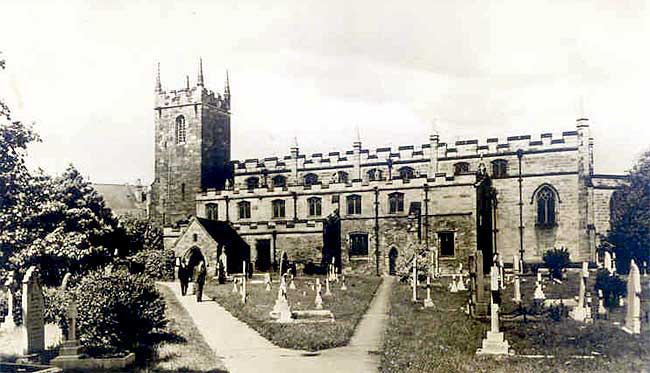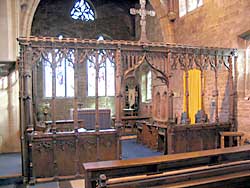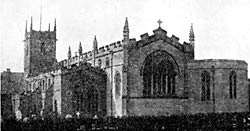
St Giles church, West Bridgford, c.1930s.
Parish Church. There is no mention made in Domesday Book (1086) of a Church at Bridgford, but there may have been, and probably was one, for both Saxons and Danes, having become Christians, would require their Church, however primitive and simple its construction, probably of timber, wattle, and daub, covered with thatch, and there being no seats on the floor. Such a building would from generation to generation require renewal, and as the people became more settled, and civilization advanced, more durable and artistic materials and workmanship would follow.
When the Priest and Churchwardens of Bridgeford went each Whitsuntide to the church of St. Mary at Southwell, to join in the solemn procession, in compliance with the direction of Pope Alexander III., in 1171, "according to the old and rational usage of that church," they took as pentecostal offerings 10d. Adbolton took 31/4d.; Edwalton 6d.; Bridgeford-on-the-Hill took 1/6. The amount roughly depended on local values. (For present values multiply twenty-five times).
On Passion Sunday in March, 1208, Bridgford Church, and all other churches in the land were closed by order of the Pope, and so continued five or six years, during which there were no public services, no sacraments, no marriages, or burials in consecrated ground, and all this simply because of a quarrel between the Pope and the King. At length the King gave way, and sold the kingdom to the Pope, receiving the kingship back as a vassal. This was a strange way of advancing Christ's Kingdom here on earth, and the transaction will never be forgotten, nor forgiven.
The Parish Church has been well described by several competent architects. Mr. Stretton's manuscript, written in 1816, has been recently published by Major Robertson. Mr. S. Dutton Walker gave a lecture on "West Bridgford, and its approaches " in 1863, and his comments on the church were extensively quoted by Mr. J. P. Briscoe in a Bazaar Handbook issued in 1895; and again Mr. Harry Gill, in a similar Handbook, issued in 1908, described each part of the sacred edifice, and reference may be made to those descriptions by persons who desire to study the building fully.
St. Giles, to whom the parish church was dedicated, was in the olden time a favourite in Notts, as a saint whose name their churches should bear, for there are ten churches in the county dedicated to him, and no wonder, for he was not only of royal descent, but from the cradle he was devoted to good works. He was an Athenian. He gave away the entire fortune that he had received, and later on he retired to a desert, where he sustained himself by herbs, and the milk of a hind that came to his cave of her own accord. He was regarded as the special patron of lepers, beggars, and cripples, and therefore of hospitals. Hence the name suggests to thoughtful minds the need for spiritual healing, true riches, and Divine strength.
The present church appears to have been built about 1300 to 1350, probably in succession to a previous one, and it consisted of a chancel with north vestry, nave, south aisle, and porch and low western tower, which, with the whole church, was embattled, there being four clerestory windows, and three bells. Mr. Stretton says, ''The east end of this chancel has been very justly remarked and admired for the beautiful and peculiar construction of its windows, which Mr. Blore observes are not to be equalled in any village church that he has seen. There are three of these windows, two below and one above them, filling up the gable end in a triangular form, and enriched with beautiful tracery, but the tasteless depravity of the churchwardens bricked them up to save the expense of glazing and repairs." There is an error here. Only the upper window was triangular, and that was bricked up, and is now stored in the porch. The chancel was repaired at considerable expense in 1833.
Many changes have been made since 1844, when the church was described as "a fine ancient edifice with tower and pinnacles which appears to great advantage peeping above the trees which surround it." There is an interesting lithograph, published in 1891, showing the termination of the footpath which led to the church from the junction of Loughborough Road and Bridgford Lane—Mr. T. C. Gray has a copy.
Mr. Walker describes at length the beautiful glass in the windows, which he regarded as highly valuable, representing our Lord in the act of shedding blessings, and granting benediction. The left hand indicated the act of bestowing. "The body was clothed with a mantle or robe, and Christ is seated upon a bench, or seat, of very elaborate workmanship, indicative of the 14th century period of Gothic art." Mr. Walker afterwards wrote a letter to Mr. Briscoe, stating that since the publication of his paper all the ancient glass had been broken. The late Mr. W. P. Phillimore wrote two articles in the Notts, and Derbyshire Notes and Queries in 1895, in which he deplored the destruction of much that was beautiful or interesting in the so-called restoration of 1871-2: "Amongst it was the coat of arms of the ancient lords of the manor—the Luterals, who died out in the male line as long ago as the year 1418. That so interesting a relic—their sole memento in the place— should have been thus destroyed is a fact which reflects great discredit upon the architect, rector, and others responsible for the restoration." (p. 130). The cost of the alteration, not restoration, was £800.
The Early English, the Perpendicular, and the Late Decorated styles are all represented here. The Decorated windows Mr. Gill places at about 1350. The tower appears to have been rebuilt at the end of the sixteenth century. The walls of the nave were then raised, and the clerestory windows added. High up on the south side of the tower is a sermon in stone, for while the name of St. Giles would suggest the need for bodily healing, the ancient Latin inscription, in old English characters, "XPC lapis adjutorii"—"Christ the Stone of help"—would suggest to thoughtful minds to Whom to go for spiritual healing, divine strength, and a sure resting place. Probably the engraver had in mind i. Sam. vii. 12., Isa. xxviii. 16, etc. Mr. Gill states that the window tracery, and the effigy of "the Stone Man," "are hewn out of the same bed of stone, i.e. the magnesian limestone, obtained from a quarry in the stone yielding district between Hucknall and Mansfield."
Mr. Phillimore has two articles in the local "Notes and Queries," 1895, in which he relates the information given him by a workman, that about 1821 "the chancel had been re-roofed, and the eastermost [uppermost] lancet then brisked up, as well as the upper part of the two east windows. In place of the pews in the chancel there were benches which had been brought from St. Mary's, at Nottingham. Over the chancel screen was a singing loft, though little used, as it was unsafe, and the wooden stair at the south end of the screen was removed. One singular assertion he made was that the original site of the church was in Barrack (?) Close, near the pinfold." p. 163.

The oak screen (photo: A Nicholson, 2005).
"Across the present south aisle, and on the site of what was originally the east wall of the chancel previously to the enlarging of the church, stands an oak screen (about 1380) of rectangular construction. The character of the framework is that of a stone screen carved out in wood, with mason joints. It comprises four compartments on each side of the central doorway." The above is copied from a descriptive article on " Roods, Screens and Lofts in Notts," by Mr. A. Vallance in " Memorials of Old Notts." At the northern end of the cornice there is a carved figure of a fox carrying a goose on his back. Was this a comic way of representing the consequences of silly conduct resulting in captivity by the devil?
The Priests' door to the old chancel, Dr. Cox places at about the middle of the 13th century. The sedilia (that is the stone seats for the clergy, now hidden behind the organ) is the only instance of its kind in the county. The corbels, supporting the ends of the arches in the arcades, have grotesque, but highly skilled carving, believed to represent some unknown spiritual truth. There was a small chantry chapel for prayers on behalf of departed souls, which was in the south aisle, and originally enclosed with a screen, and furnished with an altar, and all other necessary fittings, but no indication of this remains, except the double piscina niches in the south wall.

The church has been twice extended within the last twenty years. A new nave and chancel was added in 1898, when the Rev. J. Robinson, M.A., was rector, the cost being about £4,500; and on the morning of the Coronation of King George V., 1911, the foundation stone was laid of a new north aisle, to be called, by special leave of the King, "King George the 5th Aisle " (hence the Royal Arms on the stone), clergy vestry, choir vestry, and morning chapel, by Mrs. Heymann, which completed the parish church, the cost being over £6,000. The result being that to a certain extent the old fabric, which has been largely preserved, has become the south aisle, as may be seen in the photo. The latter work was completed under the Rectorship of the Rev. R. Hargreaves, M.A., and now forms not only a fine parish church, but one of the most spacious in the diocese. The church plate includes a cup, dated 1659, and a paten cover, 1564-5 This is said to be the oldest piece of Elizabethan plate at present known in Notts.
Registers. Particulars as to the Registers of marriages, births and deaths may be seen in Godfrey's "Churches of Notts.'' (Hundred of Rushcliffe, page 284). It is noted that during the Commonwealth, 1653, Francis Smith was nominated and chosen by the major part of the parishioners there to be their parish Registrar. The marriages in West Bridgford from 1559 to 1812 have been transcribed by Mr. F. A. Wadsworth, and published by Phillimore & Co., Vol. VII., and comprise nearly 700 couples. Those since 1812 have not been extracted.
Rectors. The first Rector, whose name has been preserved, was Luke de Crophill, in other words, Luke, of Cropwell, 1239, the Patron then being Sir Andrew Luterell, Knight, and three members of the Luterell family followed as Rectors. The Luterell family patronage continued nearly two hundred years, but in 1437 Sir Godfrey Hilton, Knight, was patron. The Rector, in 1517, was described as "parson of ye ch: of Briggeford next the Bridge-End of Notts." In 1536 the Rector of Westburghford is named. (Godfrey). The Rev. Francis Withington, M.A., was instituted in 1614, but the benefice was sequestrated during the Commonwealth, and Walker's "Sufferings of the Clergy" (p. 424), says of Mr. Withington, "He was taken into custody by the House of Commons." It must not be assumed that he had done some moral wrong. It may be he was charged with "malignity," in other words that he adhered to the King, and was against the Parliament. It is not unlikely that he was, for those days, fairly elderly. Many of the clergy who refused compliance with the new order of things were ejected from their livings, and some were even imprisoned. The Rev. Samuel Cotes, M.A., was in 1650 the "preaching minister," and the rectory was then valued at £90 per annum. In the parish register of marriages is an entry, " Mr. Samuel Cotes, Rector of West Bridgford, and Mrs. Suana Vinsent, of Barnbor, published 6 Nov. 1659. Banns only." Signed Sa. Cotes, Rector.
Tithes. The tithes were commuted in 1840 for £202. Query, were they previously collected in kind ? If so, was there a tithe barn ?
"The Rectors of Gamston and West Bridgford having had many disputes on the division of the tithes of Gamston an Act of Parliament was obtained in 1809 for apportioning to each his share." The Rector of Gamston must mean the lay Rector, that is the owner of the large tithes.
